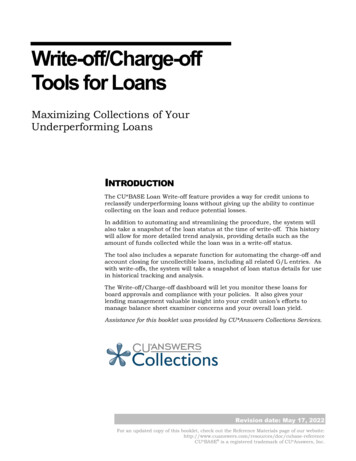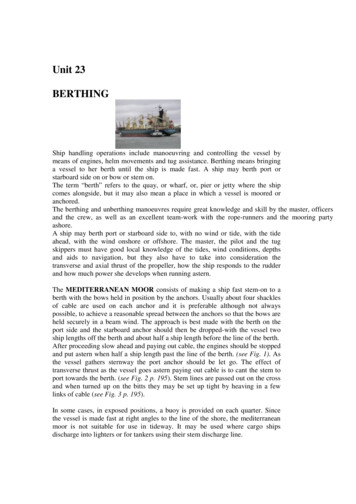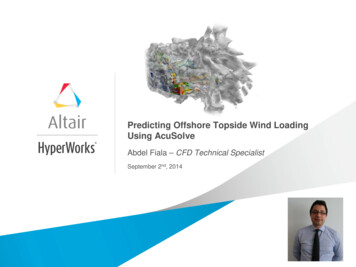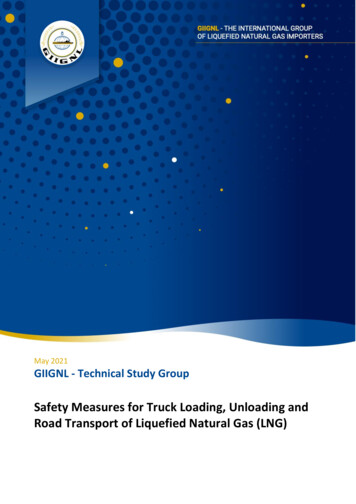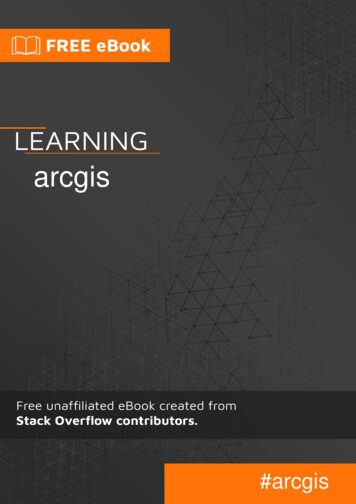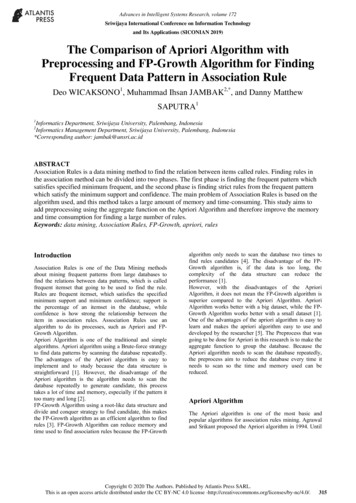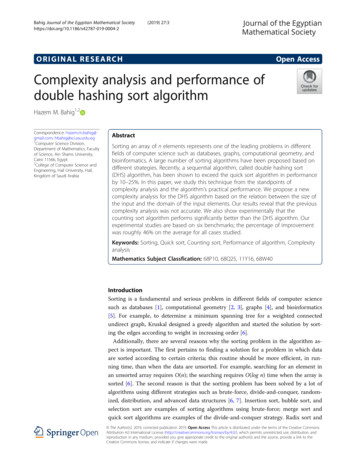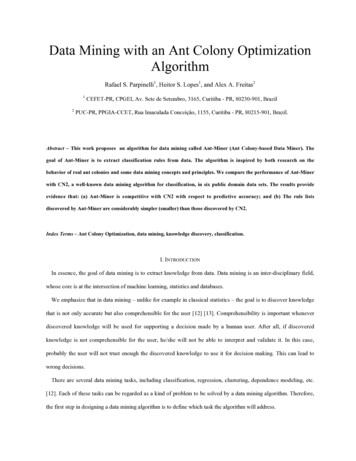
Transcription
COEN 241 – Cloud ComputingProject: Off-Loading Algorithm on Simulated Mobile EdgeComputingByLiang Xia, Weiben Zhang, Xuemei Wei, Nuo DouDate: June 12, 2017Prof. Dr Ming-Hwa Wang1
PrefaceSince the invention of iPhone and Android mobile devices, smartphones have changed people’slifestyles enormously. Correspondingly, more and more mobile applications are developed, suchas face recognition, interactive games, natural language processing, to fulfill all the aspects ofdemands. However, as these applications become more and more complicated, the conflictsbetween mobile devices’ limited computation capacity and resource hungry applications aremore and more intense. Thus, to solve the conflicts, people come up with the cloud service formobile devices.List of Figures:Figure 1: Relation among Cloud Computing, Mobile Cloud Computing, Mobile CrowdComputing5Figure 2: Workflow of offloading tasks12Figure 3: Class Design14Figure 4: Initialize customized tasks15Figure 5: Start running jobs15Figure 6: Choosing a channel randomly15Figure 7: Offloading decisions15Figure 8: Process tasks on base station15Figure 9: cloud server processes tasks15Figure 10: Results in the log file16Figure 11: Energy and Time Saved under Different Battery Level with 30MB Data ofEMU17Figure 12: Energy and Time Saved under Different Data Sizes with 75% Battery Levelof EMU17Figure 13: Average Energy and Time Saved under Different Number of Devices ofDynamic Algorithm18Figure 14: Dynamics of system-wide computation overhead18Figure 15: Execution Time of DPR for a different number of tasks19Figure 16: Program flowchart21Table of t is the problemWhy this is a project related to this classWhy other approach is no good and your approach is better2
21.5 Area or scope of investigation5Theoretical Bases And Literature Review52.12.22.32.42.52.62.75666677Definition of the problemTheoretical background of the problemRelated research to solve the problemAdvantage/disadvantage of those researchYour solution to solve this problemWhere your solution different from othersWhy your solution is .77778888567How to generate/collect input dataHow to solve the problemAlgorithm designLanguage usedTools usedHow to generate outputHow to test against hypothesisImplementation85.1 Code (refer programming requirements)5.2 Design Document and Flowchart812Data Analysis and Discussion146.16.26.36.414161618Output GenerationAbnormal Case ExplanationOutput AnalysisCompare Output against HypothesisConclusions and Recommendations197.1 Summary and Conclusions7.2 Recommendations for Future Studies19198Bibliography209Appendices203
1. Introduction1.1Objective:Though mobile-edge cloud computing helps solve the conflicts, it cannot be randomly applied.Before offloading local computation tasks from mobile devices to the cloud, there should becertain algorithms to evaluate the performance, to determine whether offloading tasks to cloudis better than computing locally. In this project, we mainly focus on these evaluation algorithmswhich are used for making offloading decisions. We firstly read papers, to explore potentialalgorithms; then we simulate the situation of the mobile-edge cloud computing, like wirelessstations and the cloud; after this, we apply the algorithms from the papers we selected; finally,we compare these algorithms against with each other, to have a performance analysis. By doingso, we can better understand the problems of mobile-edge cloud computing and the commonsolutions.1.2What is the problem:The tension between resource-hungry applications and resource-constrained mobile deviceshence poses the emerging of mobile-edge cloud computing. Computation capability: due to the physical constraint, mobile devices can only providelimited computation resources. Short battery life: the battery cannot last very long especially when performing tasks. Modern mobile applications are more and more resource-hungry which is too costly formobile devices.1.3Why this is a project related to this class?The class is about Cloud Computing and Mobile Edge Computing is part of Cloud Computing.Here we give the relationship among Cloud Computing, Mobile Cloud Computing and MobileCrowd Computing(Mobile Edge Computing) in Figure 1. The difference between Mobile cloudComputing and Cloud Computing is that Mobile Cloud Computing only caters to mobile clientswhile Cloud Computing caters to both mobile and stationary clients. The difference betweenMobile Edge Computing and Mobile Cloud Computing is Mobile Edge Computing only movesstorage /computation to external mobile resources.4
Figure 1 Relation among Cloud Computing, Mobile Cloud Computing, Mobile Crowd Computing1.4Why other approach is no good and your approach is better?There are two other potential models for mobile cloud computing. One is to offload tasks toremote public cloud, another one is named as cloudlet based mobile cloud computing. Theproblems for Offload Tasks to Remote Public Cloud are the hard-to-reduced long latency. Theproblem for Cloudlet Based Mobile Cloud Computing is that it cannot provide accessible cloudservice to users at anytime and anywhere, also the computation power of its cloud serviceprovider may also be limited due to the physical constraints. By using cellular wireless networkand fiber link, the MEC solves both the latency and coverage problems.For the algorithm, the most well-known algorithm is called Cross Entropy Based CentralizedOptimization. This algorithm works the best when all the detailed information of users are knownby the wireless stations. However, to gain the information, the cost of the overhead of datacommuting may be too high. Whereas, the algorithms we are going to apply in this project canmake decisions based on limited information. Thus, in real situation, the algorithms applied inthis project are more applicable.1.5Area or scope of investigation:We mainly focus on two algorithms. One is designed based on a static-scenario which assumesthe number of users remains unchanged during an off-loading period. The other is designedbased on the Dynamic Programming, which is an optimization technology that transformingcomplex problems into a sequence of general problems, with Randomization strategy. Also,before implementing the algorithm, we have to simulate the real situations. Additionally, energysaving, pervasive computing and base station technologies are included in investigation.2. Theoretical Bases And Literature Review2.1Definition of the problem5
The problem includes the simulating of the real mobile-edge cloud computing scenario which isrequired before implementing problem, implementing the offloading algorithms basing on the hechosen papers and analyzing performance by specially designed input and configuredparameters.2.2Theoretical background of the problemAs stated in the preface part, offloading tasks to cloud may or may not be beneficial, whichdepends on the cost evaluation results on both offloading tasks to cloud and completedcomputing locally. Thus, before sending tasks out, the evaluation should be done. The problemincludes: how to properly define the system model to modulate actual situation intomathematical expressions; how to subtract formulate from information gained in last step; howto apply the formulations into real situation to analyze; and how to analyze performance. Thepapers that will be studied in this project solve the questions above perfectly, which providessolid background.2.3Related research to solve the problemThe related research covers a very large field, including studies on energy saving issues,pervasive computing issues and even on wireless station issues, etc, The authors of two mainpapers that are studied in this project read through those related research detailed, and finallyprovide comprehensive algorithms.2.4Advantage/disadvantage of those researchIn the paper Efficient Multi-User Computation Offloading for Mobile-Edge Cloud Computing, theauthors proposed a very efficient algorithm. It provides better performance than CE BasedCentralized Offloading algorithm if we take the consumption of parameters exchange intoaccount. However, the disadvantage of this algorithm is that it is designed basing on a staticscenario which assumes the number of users are never changed. Thus, this algorithm may failto work properly when the number of users fluctuates.In the paper A Dynamic Programming Offloading Algorithm using Biased Randomization, theauthors propose a self-adjustable algorithm which can find near-optimal solutions quickly.However, since the authors assume and analyze basing on WiFi network connection, theperformance may vary when the mobile devices are under 3G/4G/LTE networks, of whichsituations the consumption of both energy and time may be higher.2.5Your solution to solve this problemThe first thing we are going to do is to simulate the real situation of mobile-edge cloudcomputing. This step can be achieved by implementing server-client application. The server isused to simulate wireless station and the cloud, and the client is used to simulate the mobiledevices. The second step is to implement the algorithms. We plan to implement two algorithmsindependently, then, if possible, we may combine these two algorithms together and implementit. Finally, we give sample inputs and parameters to test and analyze performance.6
2.6Where your solution different from othersFor the algorithm part, our Nash Equilibrium Based Algorithm is a mobile device makingdecision model, while most other algorithms are centralized model which means Base Stationwill make a decision for mobiles to choose which task should be offloaded to cloud, which wouldstay in local to compute.For the implementation part, the main difference is where and whom the algorithms are going toapplied to. In the original papers, the author apply and analyze algorithms on actual mobiledevices and wireless stations. However, considering the lack of knowledge on mobile part, wecan only achieve it by simulated server-client application. This may cause the results differentwith the papers’, but should not be a very big difference.2.7Why your solution is betterFor the algorithm part, our algorithm will combine the advantages from the Nash EquilibriumAlgorithm and Biased Randomization Algorithm. First Nash Equilibrium Algorithm have a goodperformance and high efficiency with a fixed number of users in the cloud while the biasedrandomization algorithm help to fit to the actual situation perfectly when mobile users join andleave the cloud dynamically.For the implementation part, the biggest benefit of our methodology also relates to the way wesimulate the real situation. By simulation, it enables us to easily configure the parameters ofboth mobile devices and wireless station, which helps to know in what case the performancecould be best. It may also be used to guide the actual design of products.3. HypothesisThe mobile devices are able to make decisions about offloading by only knowing limitedinformation. The performance of applied algorithms should be much better than both theperformance of locally computing and plain cloud computing, which randomly chooses channelsto offload tasks, but it may be lower than CE Based Centralized Offloading algorithm. Thealgorithms may be unable to work properly when the number of users is changed duringoffloading period.4. Methodology4.1How to generate/collect input dataRunning client with a parameter as a weight value to simulate off-loading tasks.4.2How to solve the problemSimulating the real situation, implementing the algorithms and analyzing the performance.4.3Algorithm designReferring to the papers.7
4.4Language usedJava4.5Tools usedEclipse IDE4.6How to generate outputPrinting logs in terminals on both clients(mobile devices) and server(base station).4.7 How to test against hypothesisMultiple users request to off-loading tasks simultaneously.User requests to off-loading tasks with different weight values. The higher the weightvalue is, the higher cost the task has.5. Implementation5.1. Code (refer programming requirements) Code of EMU’s offloading algorithm/*** Use Efficient Multi-user Algorithm to make offload decision* @param device : current mobile device* @param port : randomized port number which was used to connect to wireless station*/public void offloadingDecisionByMEC(MobileDevice device, int port) {// get the port which provides best performanceint bestPort calculateOverheadForMEC(port, device);// set the portdevice.setTargetPort(bestPort);// decide offloading weight according to the status of current devicesetOffloadingWeight(device);} Code of dynamic offloading algorithm/*** Use the Dynamic Algorithm to make offload decision* @param device : current mobile device*/public void offloadingDecisionByDynamic(MobileDevice device) {// the matrix is a list of integer which stores decisons for all the tasks// to make it consistent, if the device's id is bigger than current list's size,// the previous not made decisions should be filled as -18
if( device.getId() matrix.size() ) {for( int i matrix.size(); i device.getId(); i) {matrix.add(-1);// -1 indicates the decision for task i hasnot made}}// random(): a 0 - 1 generator which is used to// generate decisions according to decision history;//if( matrix.get(device.getId()) -1) {matrix.set(device.getId(), random());}// use the dynamic algorithm to make decisionif( matrix.get(device.getId()) 0 && !isBeneficial(device) ) {// offloading is not applicable, set offloading weight to 0device.setOffloadWeight(0);}} Code that helps dynamic offloading algorithm to find best channel/*** To see whether a decision is beneficial for dynamic algorithm* @param device* @return*/public boolean isBeneficial(MobileDevice device) {// connectionInfo of the wireless stationHashtable Integer,Integer connectionInfo WirelessStation.getConnectionInfo();//get the total time span to complete the taskdouble localTimeOverhead device.getCompletelyLocalySpan();//get the total energy consumptiondouble localEnergyOverhead localTimeOverhead/2;double minCloudOverhead Double.MAX VALUE;int transferTimeSpan -1;int bestPort -1;// compare each channel's overhead with locally computing's, and to find// a best channel which gives best performancefor( int port : WirelessStation.getPorts()) {int lossFactor connectionInfo.get(port) * 2;9
double curOverhead 6 ( (double) device.getDataSize() /(double)WirelessStation.getBandWidth()) * lossFactor ( (double) device.getDataSize() /(double)WirelessStation.getBandWidth()) / 3;if( curOverhead minCloudOverhead) {minCloudOverhead curOverhead;transferTimeSpan device.getDataSize() /WirelessStation.getBandWidth() * lossFactor;bestPort port;}}if( minCloudOverhead (localTimeOverhead localEnergyOverhead)) {if( transferTimeSpan 30) return imeSpan ) ;device.setOffloadWeight(1);return true;}return false;} Code that helps EMU algorithm to find the best channel/**** calculate overhead for emu algorithm* @param connectionInfo* @param port* @param device* @return*/public int calculateOverheadForMEC(int port, MobileDevice device) {//get current connection infoint currentChannelConnectionNum WirelessStation.getConnectionInfo().get(port);int lossFactor WirelessStation.getLossFactor();int bandWidth WirelessStation.getBandWidth();// get current overheaddouble currentOverHead ionNum, bandWidth);10
// get conditional overhead which represents the overhead to let the task useanother channeldouble conditionalOverhead ionNum - 1, bandWidth);// calculate other channel's overhead and find a best onedouble[] connections new double[WirelessStation.getPorts().length - 1];double[] lossFactors new double[connections.length];double[] overheads new double[connections.length];int[] ports new int[overheads.length];int index 0;for( int otherPort : WirelessStation.getPorts() ) {if( otherPort port) continue;//overheads[index] ;connections[index] ;lossFactors[index] ns[index]);ports[index] otherPort;currentOverHead ndWidth);index ;}index 0;for( int i 0; i overheads.length; i) {overheads[i] conditionalOverhead calculateOverhead(lossFactor,connections[i] 1, bandWidth);}double minOverhead currentOverHead;int bestPort port;// get the best channel//System.out.println("initialOverhead: " currentOverHead);for( int i 0; i overheads.length; i) {if( minOverhead overheads[i]) {minOverhead overheads[i];bestPort ports[i];}}return bestPort;}11
5.2. Design Document and Flowchart Workflow of offloading tasksFigure 2 Workflow of offloading tasksStep 1: Mobile device sends request to base station to get base station’sinformation.Step 2: Base station responses mobile device with information of availability andusage.Step 3: Mobile device makes decision of offloading task based on the offloadingalgorithm. Then it sends the request to the base station with its choice.Step 4: Base station gets the request and offload the task in the targeted channel.Once previous tasks are finished in the same channel, the task will be sent to thecloud for calculation.Step 5: Cloud responses the result back to the base station.Step 6: Base station forwards the result back to the mobile device then removes thetask from the channel. Class Design12
13
Figure 3 Class Design6. Data Analysis and Discussion6.1. Output Generation Wireless station, cloud server and mobile devices initializedFigure 4 Initialize customized tasks Devices start to run14
Figure 5 Start running jobs Devices randomly choose a channel at firstFigure 6 Choosing a channel randomly Offloading decisions madeFigure 7 Offloading decisions Wireless station receives requests and transfer data to cloud serverFigure 8 Process tasks on base station Cloud server receives requests and starts to runFigure 9 cloud server processes tasks15
An example of log informationFigure 10 Results in the log file6.2. Abnormal Case Explanation Sometimes, if mobile devices randomly choose the channels which finish the taskbefore getting the new tasks, randomly choosing channels will have higherperformance compared to using offloading algorithms. Sometimes, the Dynamic Offloading Algorithm may let most of tasks to computelocally and only let several of tasks to be offloaded to the cloud. This happensbecause the Dynamic Offloading Algorithm doesn’t care about the optimal solutionfor all the tasks, but just want to let the total execution time shorter than theconstraint and minimize the total energy consumption. Sometimes, the EMU offloading Algorithm may give bad performance, this happenswhen the number of devices changes rapidly, which cause the situation of decisionmaking period totally different with the situation when the task offloads to the cloud.6.3. Output Analysis Energy and Time Saved under Different Battery Level with 30MB Data of EMUOffloading Algorithm16
Figure 11 Energy and Time Saved under Different Battery Level with 30MB Data ofEMU Energy and Time Saved under Different Data Sizes with 75% Battery Level of EMUOffloading AlgorithmFigure 12 Energy and Time Saved under Different Data Sizes with 75% Battery Level ofEMU Average Energy and Time Saved under Different Number of Devices of DynamicOffloading Algorithm17
Figure 13 Average Energy and Time Saved under Different Number of Devices ofDynamic Algorithm6.4. Compare Output against HypothesisFigure 14 Dynamics of system-wide computation overheadAccording to the figure at above, the reduced overhead of EMU offloading algorithmtends to be steady when the number of devices increase, which is same as theinformation shown in Figure 11.18
Figure 15 Execution Time of DPR for a different number of tasksAccording to the figure at above, the execution time keeps increasing when the numberof devices is not very big and tends to be steady when it becomes big enough, which isthe same as the Figure 13.7. Conclusions and Recommendations7.1. Summary and ConclusionsMEC technology focuses on the end-user customer experience. The end device isdefined as a mobile device. The user is not only able to access deployed services butalso able to have local computing resource. Basically, on the local device, it has todeploy the client. The core tasks includes task dividing policy, distribution of thesubtasks on local devices or task offloading on mobile edge devices.Problems with high dynamic situation: Load variance of services Load variance of local devices and the changes of available resources includingbattery and cpu. Mobility that users’ information has to be updated frequently.Optimization goals: Application response time Battery consumption Cost7.2. Recommendations for Future Studies19
Since the MEC environment is complicated, many factors may impact the result. It issignificant to do tradeoff decisions based on the actual needs. The challenges we mayface in future work will be the topics like: Building multi-tenancy architecture by using pure cloud technology:MEC servers cannot rely on the advantages of high availability and highperformance from large-scale data center since the location may be far away andthe capability is lower. Therefore, it needs pure cloud technology to separate thefunctionalities of the services on different MEC servers to ensure each MEC serverhas high availability and high performance with limited resource for the specificservice.Network control system of separating services of control level and user level:If MEC servers are deployed close to access point of network edge, it requestsmassive network configuration and maintenance. Network control system simplifiesthe network construction and prevents routing loop and high load issues.Real-time entertainment:High-definition video service based on MCDN, AR/VR mobile interactive gamingand intelligent vehicles request MEC servers have fast response to the real timetasks of calculation.8. Bibliography[1] X. Chen, L. Jiao, W. Li and X. Fu, "Efficient Multi-User Computation Offloading forMobile-Edge Cloud Computing," in IEEE/ACM Transactions on Networking, vol. 24, no.5, pp. 2795-2808, October 2016.[2] H. Shahzad and T. H. Szymanski, "A Dynamic Programming Offloading AlgorithmUsing Biased Randomization," 2016 IEEE 9th International Conference on CloudComputing (CLOUD), San Francisco, CA, 2016, pp. 960-965.9. Appendices9.1. Program flowchart20
Figure 16 Program flowchart21
Here we give the relationship among Cloud Computing, Mobile Cloud Computing and Mobile Crowd Computing(Mobile Edge Computing) in Figure 1. The difference between Mobile cloud Computing and Cloud Computing is that Mobile Cloud Computing only caters to mobile clients while Cloud Computing caters to both mobile and stationary clients.
